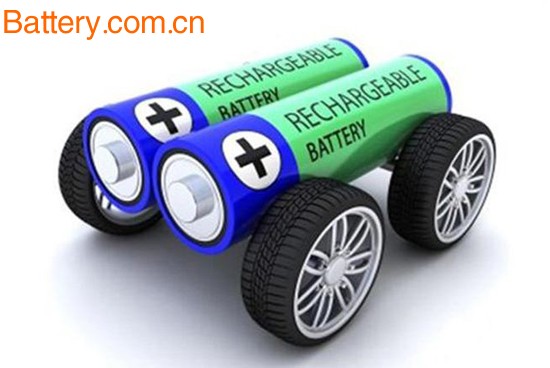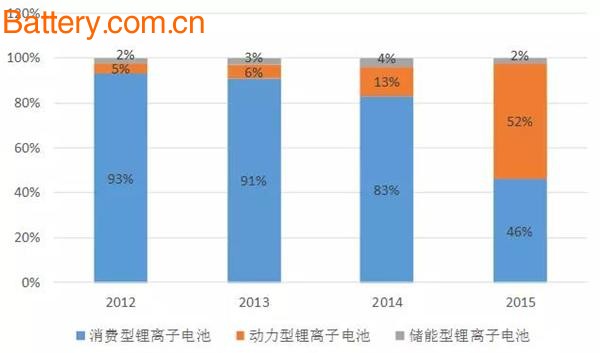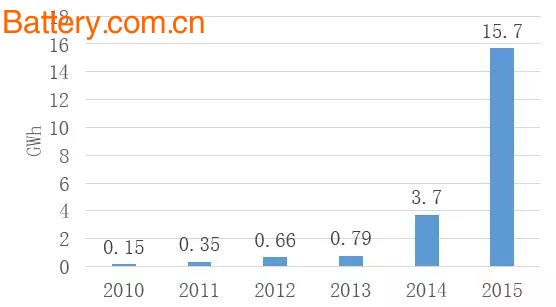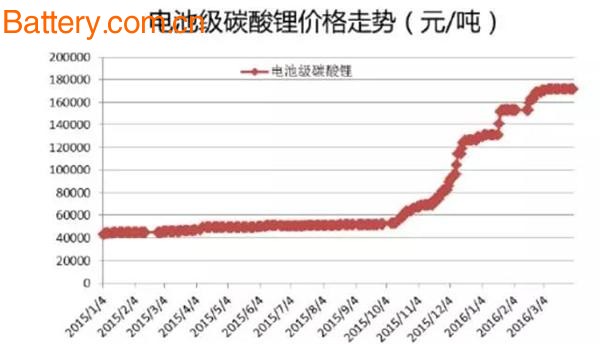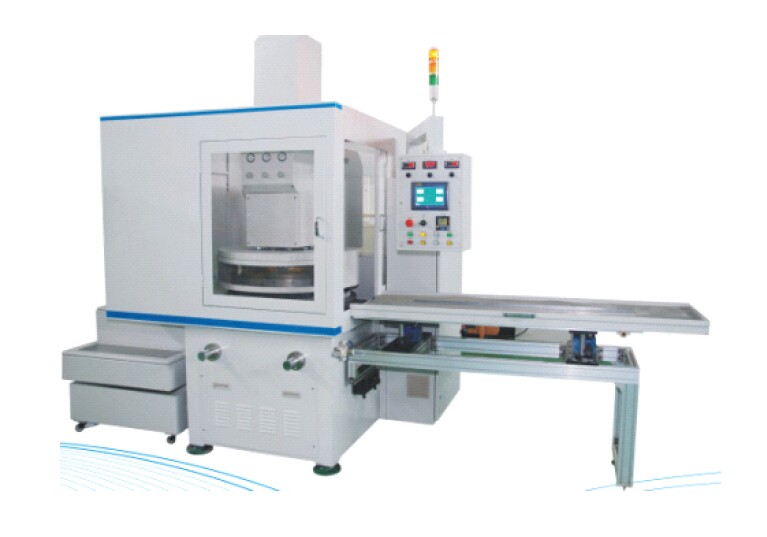As the core component of new energy vehicles, the power lithium battery has ushered in a high-speed development period with the outbreak of China's new energy automobile industry. At this stage, China's automotive lithium battery industry has achieved good results, but the problem is also very prominent. This paper firstly combs the current status and background of the domestic lithium battery industry development from the aspects of industry output, shipment volume, technology level, policies and regulations. Secondly, it comprehensively analyzes the capacity, announcement management and technical route of the lithium battery industry for vehicles. Various problems in technical level, battery safety and recycling; finally, relevant suggestions for improving the competitiveness of China's automotive lithium battery industry are given. In the relatively low global economic situation, China's automotive lithium battery industry in 2015 has achieved good results, such as rapid increase in shipments, industrial investment surge, technical level has improved significantly, and policies and regulations have been continuously improved. However, behind the fierce market, it is necessary to clearly recognize that there are still some outstanding problems in the development of China's lithium battery industry. Compared with foreign countries, there are still some gaps, which must be studied from policies and regulations, standard systems, and key technologies. The company continues to cultivate and enhance the competitiveness of China's automotive lithium battery industry. Development Status of Automotive Lithium Battery Industry in China 1. The output of lithium battery increased slightly, and the proportion of power type increased rapidly. In 2015, the cumulative output of lithium-ion batteries in China was 5.60 billion, which was only 3% year-on-year. Although the output of lithium-ion batteries in China has only achieved a small increase, the application of lithium-ion batteries has undergone a fundamental change. The market share of power-type lithium batteries exceeded that of consumer-type lithium batteries for the first time, reaching 52%, an increase of about 39% compared with 2014. It is expected that the power lithium battery will continue to dominate the lithium battery market in the future, and the consumer lithium battery market will further decline. In addition, with the gradual maturity of the power battery ladder technology in the energy storage market, the market for energy storage lithium battery will expand. Changes in the application field of lithium-ion batteries in China from 2012 to 2015 2. Power battery shipments surge, lithium iron phosphate still dominates Since 2014, with the rapid increase in the output of new energy vehicles, the demand for lithium-ion batteries for vehicles has continued to break out. According to high-tech lithium battery data, China's power battery shipments reached 15.7GWh in 2015, a year-on-year increase of 3.24 times. From the trend of shipments in the past five years, the shipment of power batteries has been lower than 1GWh before 2014. In 2014, it broke through 3GWh for the first time, and the market began to enter an outbreak period, which is closely related to the development trend of China's new energy vehicle market. . China's power battery shipments from 2010 to 2015 From the perspective of battery material type, the new energy vehicle battery is mainly lithium iron phosphate material, accounting for 69%, followed by ternary material battery accounting for 27%, lithium manganate, lithium titanate, super capacitor, nickel hydrogen battery Other materials such as battery shipments accounted for only 4%. In terms of models, passenger cars are mainly ternary materials, and commercial vehicles are mainly lithium iron phosphate. 3. The technical level has improved significantly, and some indicators have reached the international level. In terms of applied materials, the current capacity of lithium iron phosphate in China is 160mAh/g, and the graphite capacity of anode material can reach 360mAh/g. The main technical indexes of electrolyte can reach the international advanced level, the conductivity of room temperature is ≤10ms/cm, and the moisture content is ≤ 110 ppm, HF content ≤ 130 ppm. In terms of group technology, China's automotive lithium battery group application technology and energy storage power system integration key technology research, has also made significant progress, dry injection, chemical composition, PACK and other technologies have reached the international advanced level. In terms of product performance, the current industrialized lithium-ion battery power density can reach 3500W/kg, the ternary lithium battery energy density reaches 180-200Wh/kg, and the multi-component lithium battery has a group life of 8000 times, which can satisfy the entire vehicle. Life cycle use. In terms of large-scale production, China has become the main production base of global lithium-ion battery for vehicles. The price of battery system has dropped from 5 yuan/Wh in 2012 to 2.5 yuan/Wh. The lithium iron phosphate industry is leading the industry in terms of maturity and scale. , ternary, lithium manganate and lithium titanate batteries for large-scale applications. In terms of equipment and technology, the degree of automation of lithium battery production equipment in China has been greatly improved. An automated production line for cylindrical power batteries has been developed, which can complete the assembly, welding, encapsulation, tab welding, capping and shell cover of the bus. 7 major processes such as top welding and shell sealing welding, 27 automatic decomposition steps, only 3 people/shifts for full line loading and unloading and inspection. 4. The upstream lithium supply is highly concentrated, and the price of lithium carbonate continues to skyrocket. China's lithium resources are abundant, but the distribution is relatively concentrated, with a focus on Qinghai, Tibet, Sichuan, Jiangxi and other provinces and cities. The domestic lithium concentrate is mainly provided by a small number of enterprises such as Tianqi Lithium, Zhonghe, and Lifeng. Affected by many factors such as high concentration of lithium resources, a small number of enterprises leading prices, and increased demand for lithium carbonate, the price of battery-grade lithium carbonate in 2015 rose from 43,000 yuan/ton at the beginning of the year to 123,000 yuan/ton at the end of the year, up nearly 3 Times. Since 2016, the price of battery-grade lithium carbonate has continued the upward trend of last year. In the second week of June, the mainstream of battery-grade lithium carbonate in the market was 1.55-16.5 million yuan/ton, and some high-end transaction prices were 16.5-17 million yuan/ton. Nearby, a small amount of 180,000 yuan / ton. The irrational increase in the prices of upstream lithium resources and lithium carbonate materials will have a certain adverse impact on the development of the lithium battery industry to a certain extent. 5. The policy and regulation system has been continuously improved and industry management has been strengthened. The Chinese government attaches great importance to the lithium battery industry for vehicles and constantly promotes the upgrading of industry standards. Li Keqiang, Premier of the State Council, stressed at the State Council executive meeting in early 2016: "Accelerate the revolutionary breakthrough in power batteries. Promote large-scale SMEs, universities, research institutes, etc. to form collaborative power, open and shared power battery innovation platform, in key materials, battery systems The commonality and basic technology research and development focus on the development. The central government adopts the award-based compensation method to reward enterprises according to indicators such as power battery performance and sales volume, and increases support for digital battery manufacturing equipment. Since 2015, China has issued several battery policy documents to strengthen industrial regulation and guidance, and promote the healthy and orderly development of the industry. These policies are mainly reflected in the following aspects: First, strengthen battery bulletin management. In March 2015, the Ministry of Industry and Information Technology issued the "Regulations on the Standards of Automotive Power Battery Industry". Through the implementation of the announcement management of the power battery industry, the company has standardized requirements on the production capacity and other indicators. On April 29, 2016, the Ministry of Industry and Information Technology issued a supplementary notice on the enterprise declaration work in line with the "Regulations on the Standards of Automotive Power Battery Industry", clearly requiring: the single enterprise that has been included in the announcement should be in accordance with GB/T 31484-2015, GB/T. 31485-2015 and GB/T 31486-2015 three standards require retesting of typical products. This means that China's previous battery testing recommendations have been converted to mandatory standards, and battery management has become more stringent and standardized. The second is to pay attention to the recycling of used batteries. Since 2016, the Ministry of Industry and Information Technology has successively issued the " New Energy Vehicle Power Battery Recycling Technology Policy (2015 Edition)", "New Energy Vehicle Waste Power Battery Comprehensive Utilization Industry Standard Conditions" and "New Energy Vehicle Waste Power Battery Comprehensive Utilization Industry Specification Announcement" The three documents of the Interim Measures for Management clarify the main body responsible for the recycling of used batteries and strengthen the supervision of industry management and recycling. The third is to clarify the industrial development goals. In the technical roadmap of the key areas of "Made in China 2025", the development goal of the new energy vehicle power battery is proposed. By 2025, the specific energy of the battery cell of the power battery system reaches 400Wh/kg or more, and the cost is reduced to 0.8 yuan/Wh. The cost is reduced to 1 yuan / Wh. China's automotive lithium battery industry development still has outstanding problems 1. Rapid expansion of production capacity, high-end shortage of low-end surplus Power battery is the core component and power source of new energy vehicles. It plays an important position in the new energy automobile industry chain, and it is easier to stimulate the investment enthusiasm of the whole society. According to incomplete statistics, the investment in the power battery program in 2015 was nearly 100 billion yuan, but what is even more terrifying is that 54 companies in the first half of 2016 released a total investment of 114 billion yuan. Lithium battery investment enthusiasm is so high, it may lead to two consequences: First, the capacity expansion. According to the statistics of lithium battery, the main power battery capacity at the end of 2015 exceeded 30GWh, and the planned construction is over 70GWh. It is expected that the production capacity will exceed 100GWh by 2018. Second, the high-end high-quality production capacity is insufficient, the low-end capacity is overcapacity, and the structural risk of the industry is rising. In terms of market concentration, the market share of the top 10 companies in China's power battery shipments reached 75.3% in 2015, and the market share was concentrated in the hands of a few companies. There are 121 power battery companies in China, and the number of enterprises that actually enter the vehicle supply system is no more than 20, and the market polarization is particularly prominent. This shows that although there are many power battery companies in China, the scale is generally small, and the problem of low-level redundant construction is serious. 2. Battery announcement management is tightening, and enterprises are not adequately responding On April 29, 2016, the Ministry of Industry and Information Technology announced the supplementary notice of the enterprise declaration work of the "Automobile Power Battery Industry Standard Conditions", requiring the typical products of 25 enterprises that have entered the 1-3 batch battery catalogue to be re-tested according to the new national standard. The report will be submitted before the end of June 2016, and the revocation announcement will not be submitted after the deadline. Although this move aims to strengthen the rigorous and standardized management of batteries, the sudden turn and tightening of battery announcement management has undoubtedly led to the lack of response of vehicle and power battery companies, causing controversy and uneasiness in the industry. The sudden change of the battery announcement management policy will bring a series of effects: First, the new energy vehicle announcement catalogue is directly linked to the battery bulletin catalogue, and the company is required to complete the re-test at the end of June, and the preparation time reserved for the enterprise is insufficient; For foreign battery companies, battery products cannot enter the announcement catalog in a short time, resulting in many domestic new energy auto companies falling into battery difficulties, and it is difficult to replace battery suppliers in a short time. 3. Battery cell performance is not bad, the gap between group technology is obvious At present, the technical level of lithium-ion battery cells developed in China is basically at the same level as that of foreign countries, but it is significantly behind the international advanced level in battery group technology. The first is the gap in the overall performance of the battery system, including energy density, temperature characteristics, power characteristics, consistency, cycle life, etc. Second, the domestic battery pack connection, heat dissipation, protection, use, maintenance, charging and other technologies The level is low; finally, there is a significant gap between the reliability of the data acquisition of the power battery system, the accuracy of SOE estimation, thermal management, balance, and safety management. 4. The technical route is controversial, and some enterprises are frustrated The promotion of new energy vehicles in China is mainly based on lithium battery and lithium ternary lithium batteries. From 2010 to 2015, lithium iron phosphate battery shipments accounted for 69%, and ternary lithium batteries accounted for 27%. . At the beginning of 2016, the Ministry of Industry and Information Technology suspended the ternary lithium battery bus into the list of recommended models for the promotion of new energy vehicles for the consideration of power battery safety issues. Although it is only a “suspensionâ€, it has a potential impact on the manufacturing and use of ternary batteries. How to balance the two issues of battery life and safety has become a focus of attention in the industry. At present, power battery safety is too focused on materials and monomers, and research on system safety is insufficient, and there is a lack of corresponding safety evaluation methods. The industry has basically reached a consensus on the application of the battery technology route, that is, the use of ternary material batteries is suspended on passenger vehicles with more load-bearing personnel and more sensitive to safety risks. Commercial vehicles and passenger vehicles such as special vehicles and logistics vehicles are not restricted for use. Three yuan battery. However, since the safety evaluation method has not been introduced, the application of the ternary battery on the passenger car has been affected to some extent. 5. Power battery automation equipment is low Manufacturing processes and production equipment are important factors in determining battery performance. At present, the consistency of China's battery core is poor, which has an important relationship with the domestic lithium battery manufacturing process, quality monitoring and equipment automation level. Japan, South Korea, etc. have adopted high-level automation equipment in the processes of feeding, mixing, pole piece and battery production, battery formation and screening, battery pack and module assembly, logistics and online quality inspection. The automation level is 80%. the above. The domestic automation battery manufacturing process automation level is relatively low, the first-line enterprise automation ratio is about 50%, the second-line enterprise is only about 20%, and the low level of automation is the direct cause of the poor consistency of China's battery cells. 6. Frequent safety incidents, battery safety needs attention Along with the rapid development of China's new energy automobile industry, new energy vehicle safety accidents have occurred from time to time. Safety issues have become the lifeblood of the development of new energy automobile industry, which is related to the healthy and sustainable development of the entire industry. According to incomplete statistics, since 2010, there have been 49 cases of new energy vehicle safety accidents in China, including 14 cases in 2015 and 15 cases in January-July 2016. The frequency of accidents has increased significantly, especially the safety of electric buses. prominent. According to the Ministry of Industry and Information Technology, as of the end of 2015, the accident rate reached 0.17‰, more than double the world average. With the increase of old vehicles, the security situation will be more severe. Analysis of 49 accidents, charging, battery failure, collision, wading, etc. are the main causes of safety accidents, in which accidents caused by battery failure exceed 50% of the total. 7. Recycling and storage technology barriers, implementation of policies is difficult In 2016, the Ministry of Industry and Information Technology released the “Technical Policy for Recycling and Utilization of Electric Vehicles for Electric Vehiclesâ€, which clarified that automobile manufacturers will become the mainstay of recycling and utilization of used electric vehicles. However, it is necessary to balance the interests between vehicle manufacturers, battery companies and consumers. The implementation is relatively difficult, specifically in the following two aspects. First, the non-standardization of the battery leads to inconvenient disassembly and safety hazards. The internal and external structural design, module connection method and process technology of the battery modules used in different models are different. When the battery is disassembled, flexible configuration is required. Before fully implementing automation, manual participation, battery short circuit, liquid leakage, etc. may be required. Causes fire or explosion, and has potential safety hazards to people and property. Second, the recycling system is immature and the recycling economy is not good. At present, the power battery recycling industry has not yet formed a scale effect. The domestic recycling system has not yet been established. Although some enterprises are involved in the power battery recycling business, they lack a certain profit point because the investment exceeds the battery value and the recycling point is small. Suggestions on Improving the Competitiveness of China's Automotive Lithium Battery Industry 1. Prevent low-level redundant construction and cultivate leading enterprises with strong competitiveness Driven by the hot new energy vehicle market, the investment in the power battery industry is large, the capacity expansion is fast, and the investment enthusiasm is unprecedented. However, due to the uneven level of domestic power battery companies, it is necessary to prevent low-level redundant construction. It is necessary to strictly enforce the access conditions of power battery companies; secondly, to strengthen the approval of new power battery projects, and refuse to pass the conditions that do not meet the requirements. To enlarge and strengthen China's power battery industry, we need to cultivate competitive leading enterprises. On the one hand, we will increase support for innovative power battery companies, and research and development funds and resources will be tilted toward key enterprises. On the other hand, we will guide key enterprises to expand through mergers, reorganizations, acquisitions, and holdings, and gradually form internationally competitive Leading enterprise. 2. Policy development should have expectations, and industry adjustment should have a buffer period The purpose of the government's policy is to better regulate and serve the development of the industry. Therefore, the policy should have certain stability and continuity to give the industry a stable expectation and adjustment. It is recommended that before the introduction of the policy on industrial adjustment, an in-depth evaluation of the impact of the policy should be carried out, and multiple opinions including enterprises should be solicited in advance to prevent the occurrence of rushing; the adjustment needs to give the enterprise sufficient buffer period, taking the battery announcement as an example, and the replacement is in accordance with The power battery required by the announcement, the OEM needs a lot of vehicle development and debugging verification work, otherwise rushing to replace the battery may reduce the safety of the car, so it is necessary to leave enough time for the OEM to replace the power battery. 3. Increase R&D investment and accelerate key technology research The central government will adopt the support method of awards and compensation as soon as possible, reward enterprises according to indicators such as power battery performance and sales volume, and actively guide funds for research and development investment. Continue to carry out major science and technology projects, increase capital investment in power batteries from the national level, and focus on supporting common and key technology research and research. Strengthen the linkage of upstream battery materials, mid-stream batteries and battery pack manufacturing, and downstream new energy auto companies, give play to the role of leading enterprises in the market, encourage key enterprises to carry out key technologies such as battery systems, single cells, and key materials, and strengthen battery environment and durability. Research on common technologies such as polarity, internal polarization distribution of batteries, and performance attenuation mechanism, strive to master the core technology of power batteries and enhance the core competitiveness of China's power battery industry. 4. Focus on battery safety research and improve safety standards system Pay attention to the innovation of battery safety technology. Intensify efforts to develop high-security, high-performance batteries. The system thoroughly studies battery cell safety, battery system safety, vehicle safety, charging safety and fire safety. Improve battery system safety testing and certification system. Increase battery thermal runaway and high-voltage electrical component testing such as connectors and cables, electrical system failure detection and fire safety measures, and pay attention to system level testing and certification. Based on the current standard system, with the goal of improving safety, the test is verified, and the project included in the mandatory test is proposed to further improve the standard. Establish a variety of different types of battery testing and evaluation system, research and verification of battery safety related detection methods such as battery thermal runaway, battery pack, battery system and collision. 5. Focus on improving the technological innovation level of lithium battery equipment Reduce the import of key equipment and accelerate independent innovation. Lithium-ion equipment enterprises should increase investment in research and development, promote the development of complete sets of automated production equipment for batteries, and strive to improve the capability of automation solutions and the supply capacity of complete line equipment. The improvement of the automation level of lithium battery equipment requires in-depth cooperation between lithium battery suppliers, lithium battery companies and new energy vehicle companies to participate in design and development. Increase the research and development of key technologies such as recycling and reuse equipment and processes. Research on dry and hydrometallurgical and biometallurgical technologies to increase the recovery efficiency of valuable metals and reduce costs. Innovate waste battery testing methods and evaluation equipment to improve the accuracy of battery reliability and life prediction. Accelerate the improvement of lithium battery equipment industry standards and manufacturing, recycling and reuse technology systems. 6. Improve industry management methods and strengthen post-event supervision The safety of the power battery is related to the user's life and property safety. Therefore, it is not only possible to regulate the development of the industry by adopting enterprise and product access. It is also necessary to strengthen the supervision of the enterprise and products in the event and afterwards, and to find out the problems in time, such as standards. Implementation is not in place, key indicators are not up to standard, etc., establish enterprise product quality files, seriously deal with battery safety accidents, and carry out necessary means including administrative and economic penalties for enterprises until the production qualifications are cancelled, the investigation process is transparent, and the entire industry is guaranteed. healthy growth. 7. Pay attention to battery recycling and improve the construction of policies and regulations Pay attention to the recycling of power batteries and speed up the construction of traceability system. Further implement the power battery coding system and traceability system required in the "Electric Vehicle Power Battery Recycling Technology Policy (2015 Edition)", formulate mandatory standards for power battery coding as soon as possible, and link the traceability system to the announcement management of new energy vehicle products. As soon as possible, standardization of battery internal and external structural design, module connection, integrated installation, etc., to ensure the convenience, safety and consistency of battery recycling. Develop and implement a power battery recycling incentive policy. Establish a clear reward and punishment mechanism, which can subsidize battery recycling enterprises according to the number of batteries, capacity, etc., and impose necessary punishments on enterprises that have not fulfilled their responsibilities; consumers can use the method of deposit and reward in parallel to guide consumers to take the initiative. Waste batteries, return deposits and add additional rewards.
High precision double side surface grinding or fine grinding is a super finishing process performed by removing material from two surfaces of a component resulting in extremely precise geometric accuracy and surface finish. Typically, it is the last grinding step of a mechanical production chain utilized to improve and/or correct the geometry of parts coming from sintering, sawing, molding or similar operations. Depending on the application, the stock removal also can be taken from just one surface.
GMM1200 Double Side Surface Grinding Machine Disc Grinder,High Precision Surface Grinding Machine,Precision Surface Grinder,Oil Nozzle Surface Grinding Machine Xinxiang SKF machinery Co., Ltd. , https://www.grindingmachine.nl